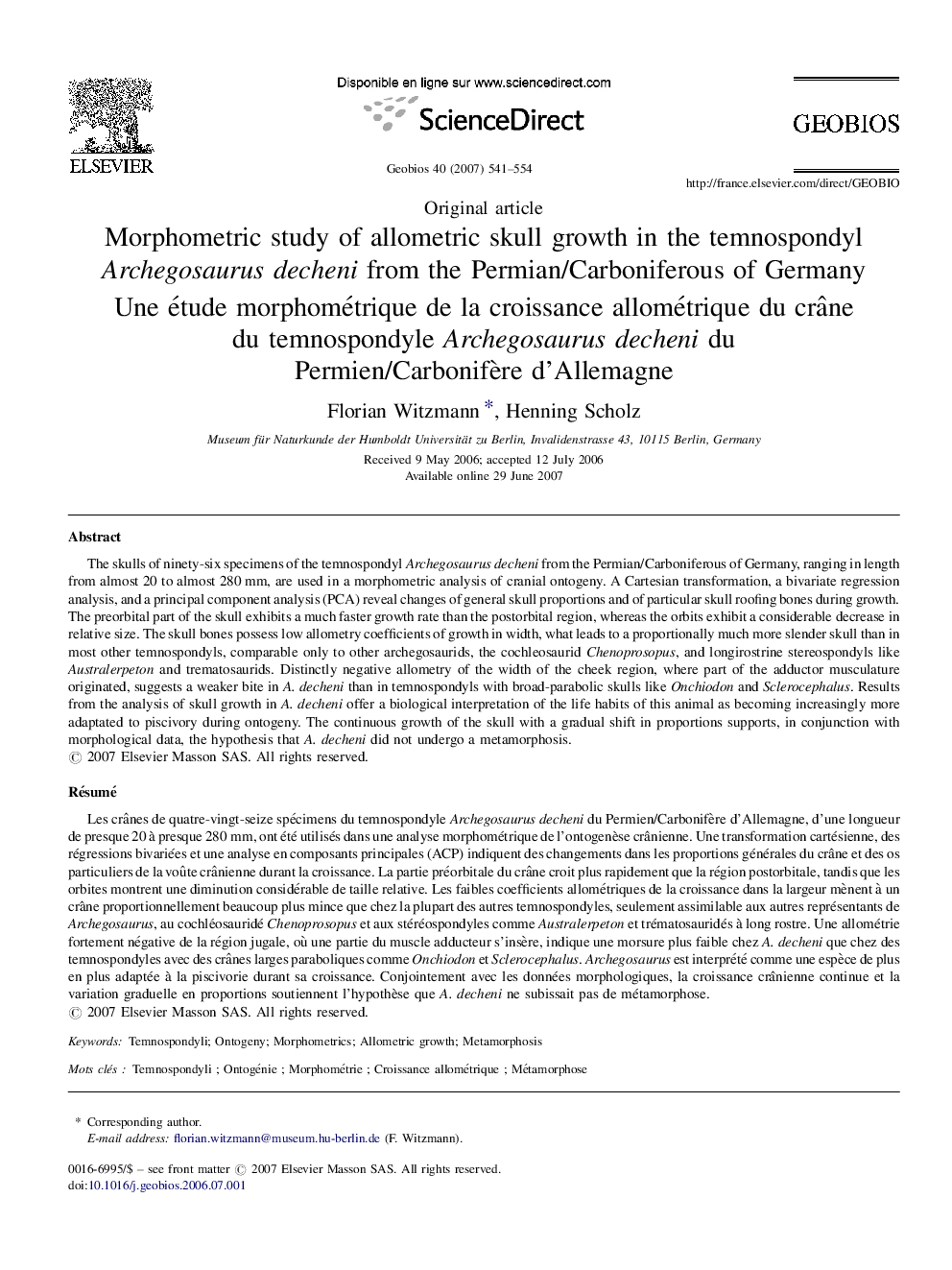| کد مقاله | کد نشریه | سال انتشار | مقاله انگلیسی | نسخه تمام متن |
|---|---|---|---|---|
| 4748642 | 1360129 | 2007 | 14 صفحه PDF | دانلود رایگان |

The skulls of ninety-six specimens of the temnospondyl Archegosaurus decheni from the Permian/Carboniferous of Germany, ranging in length from almost 20 to almost 280 mm, are used in a morphometric analysis of cranial ontogeny. A Cartesian transformation, a bivariate regression analysis, and a principal component analysis (PCA) reveal changes of general skull proportions and of particular skull roofing bones during growth. The preorbital part of the skull exhibits a much faster growth rate than the postorbital region, whereas the orbits exhibit a considerable decrease in relative size. The skull bones possess low allometry coefficients of growth in width, what leads to a proportionally much more slender skull than in most other temnospondyls, comparable only to other archegosaurids, the cochleosaurid Chenoprosopus, and longirostrine stereospondyls like Australerpeton and trematosaurids. Distinctly negative allometry of the width of the cheek region, where part of the adductor musculature originated, suggests a weaker bite in A. decheni than in temnospondyls with broad-parabolic skulls like Onchiodon and Sclerocephalus. Results from the analysis of skull growth in A. decheni offer a biological interpretation of the life habits of this animal as becoming increasingly more adaptated to piscivory during ontogeny. The continuous growth of the skull with a gradual shift in proportions supports, in conjunction with morphological data, the hypothesis that A. decheni did not undergo a metamorphosis.
RésuméLes crânes de quatre-vingt-seize spécimens du temnospondyle Archegosaurus decheni du Permien/Carbonifère d’Allemagne, d’une longueur de presque 20 à presque 280 mm, ont été utilisés dans une analyse morphométrique de l’ontogenèse crânienne. Une transformation cartésienne, des régressions bivariées et une analyse en composants principales (ACP) indiquent des changements dans les proportions générales du crâne et des os particuliers de la voûte crânienne durant la croissance. La partie préorbitale du crâne croit plus rapidement que la région postorbitale, tandis que les orbites montrent une diminution considérable de taille relative. Les faibles coefficients allométriques de la croissance dans la largeur mènent à un crâne proportionnellement beaucoup plus mince que chez la plupart des autres temnospondyles, seulement assimilable aux autres représentants de Archegosaurus, au cochléosauridé Chenoprosopus et aux stéréospondyles comme Australerpeton et trématosauridés à long rostre. Une allométrie fortement négative de la région jugale, où une partie du muscle adducteur s’insère, indique une morsure plus faible chez A. decheni que chez des temnospondyles avec des crânes larges paraboliques comme Onchiodon et Sclerocephalus. Archegosaurus est interprété comme une espèce de plus en plus adaptée à la piscivorie durant sa croissance. Conjointement avec les données morphologiques, la croissance crânienne continue et la variation graduelle en proportions soutiennent l’hypothèse que A. decheni ne subissait pas de métamorphose.
Journal: Geobios - Volume 40, Issue 4, July–August 2007, Pages 541–554